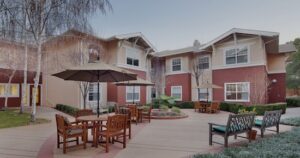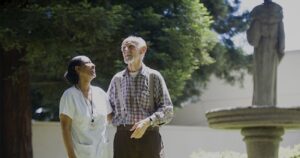Increased social interaction can benefit senior health and wellness.
Walking into the gathering room at AlmaVia of San Francisco, you might see a group of seniors participating in a book club, exercising, working on a group art project, or sipping coffee and chatting.
Creating social experiences for residents is an important part of life at Elder Care Alliance communities. When new people join the community, they are paired with a longtime resident who introduces them to others and helps them acclimate to the community.
Staff members get involved, too. Residents complete a Life Story, which helps staff learn more about each resident. Then staff takes the time to personally invite residents to activities that match their interests. “If they’re interested in knitting, talking about current events or watching sports, we make sure they get to those activities so they can do what they enjoy and meet people with similar interests,” says Allison Zalko, Life Enrichment Director at AlmaVia of San Francisco.
Physical and Emotional Benefits of Senior Living Communities
The focus on socializing is as much about creating community as it is about supporting health and wellness. As people age, their risk for social isolation increases. In 2012, about 28% of people over age 65 lived alone. Faced with declining mobility, loss of driving ability, and other factors, it can become increasingly difficult for seniors to maintain relationships or form new ones. This can result in loneliness, which can have a devastating impact on emotional wellness. People who are lonely can experience depression, high levels of stress and diminished self-esteem.
In addition to promoting emotional wellness, increased social interaction can also benefit physical health. Socially active seniors have a slower progression of health decline, lower blood pressure and lower mortality rates. Zalko says she can see the positive effect that socialization has on seniors’ physical wellness at AlmaVia of San Francisco.
Senior Living Communities Can Help Reduce Loneliness
For many seniors, the ideal solution to reducing isolation is moving to a senior living community. These communities offer a variety of opportunities to enjoy meaningful social interaction, reduce loneliness and benefit overall health. Zalko points out that the opportunity to form new friendships has a positive effect on residents. “They’re engaging with other seniors, rediscovering hobbies, learning new things and engaging in activities as well as with the community.”
Residents coordinate with each other to attend exercise classes and encourage others walk to and from their rooms. “As some residents decline, the high-functioning residents take care of them, take them under their wing and check on them,” Zalko says. “It’s a great bond to see.” This illustrates the direct links between all of the components of wellness, and is a real world example of the vital role emotional and social wellness plays in supporting the whole person.




















